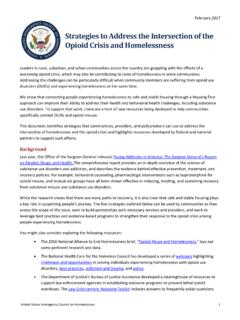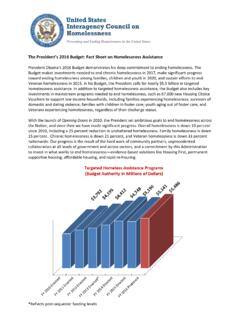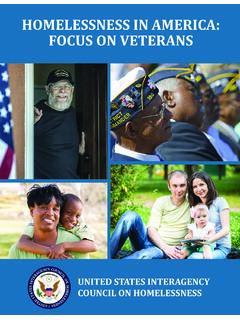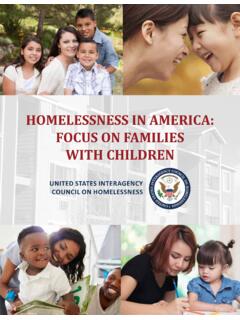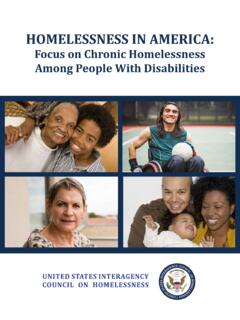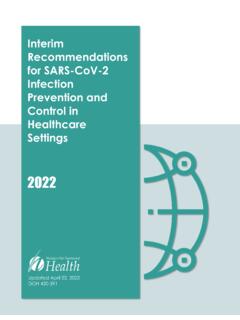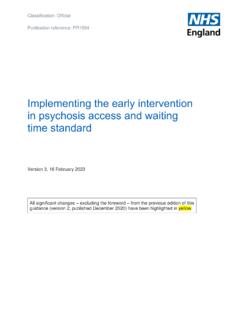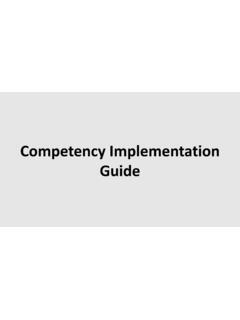Transcription of Key Considerations for Implementing Emergency Shelter ...
1 August 2017 This resource was developed in partnership with the Minnesota Office to Prevent and End Homelessness and the Minnesota Department of Education. 1 Key Considerations for Implementing Emergency Shelter Within an Effective Crisis Response System Introduction The Federal Strategic Plan to Prevent and End Homelessness calls on communities to transform their homelessness services into crisis response systems that prevent homelessness whenever possible and rapidly return people experiencing homelessness to stable housing. While some communities are documenting significant reductions in their annual Point-in-Time counts, others are faced with increasing numbers of people living unsheltered. Such communities are not only looking critically at strategies to address the immediate safety and health concerns of people experiencing unsheltered homelessness, but they are also working quickly to develop more pathways into housing people can afford and to better leverage mainstream workforce, housing, and health care systems to expand permanent solutions.
2 Emergency Shelter can and must play an essential role within an effective, housing-focused crisis response system. However, it should not be assumed that every community in which there are currently people experiencing unsheltered homelessness needs to expand the supply of Emergency Shelter . Communities should also consider how a broad range of changes and improvements within their crisis response systems will impact the need and demand for Emergency Shelter and other crisis housing. This document presents key Considerations for ensuring that Emergency shelters and similar crisis settings (referred to collectively as Emergency shelters ) are equipped to provide low-barrier access and to create quick and effective pathways to permanent housing. While the focus of this document is on the role of Emergency shelters, they should not be thought of as the only part of a community s crisis response system.
3 An end to homelessness requires the prevention of homelessness whenever possible, identification of and engagement with people experiencing unsheltered homelessness or living in encampments to connect them to crisis services, as well as pathways back to safe living arrangements or directly into housing for people in Emergency Shelter , as well as for people who never enter Emergency Shelter . We have identified specific areas of focus for strengthening the implementation and impact of Emergency Shelter . These are to: Promote dignity and respect for every person seeking or needing Shelter Divert people from the homelessness service system when possible Adopt a Housing First approach and create low-barrier access to Emergency Shelter Equip Emergency shelters to serve as a platform for housing access August 2017 United States Interagency Council on Homelessness 2 Emergency Shelter : An essential Component of a Crisis Response Responding effectively to homelessness requires a combination of strategies at the local level: preventing or diverting people from experiencing homelessness whenever possible; ensuring people transition rapidly from homelessness to housing and services; and providing immediate low-barrier Shelter options for people experiencing homelessness who cannot immediately access permanent housing.
4 These strategies are reflected in the federal criteria and benchmarks, which set the vision for what it means for communities to end homelessness among Veterans, people experiencing chronic homelessness, families, and youth. Common across these criteria and benchmarks is the understanding that ending homelessness requires that people have immediate access to Emergency Shelter and other crisis settings when they need and want it. Emergency Shelter should support flow from a housing crisis to housing stability, in which the aim of the system is to produce the most rapid and effective permanent housing connections for individuals and families facing crises. Unfortunately, many communities are facing high numbers of people experiencing unsheltered homelessness sometimes in the form of encampments as well as the need to address long stays in Emergency Shelter . This can result in limited capacity to provide immediate Emergency Shelter access to everyone who needs it.
5 Additionally, high barriers to entering Emergency Shelter , too many rules within Emergency Shelter , curfews that make it difficult to maintain a job, and a lack of focus or capacity to rapidly connect people to permanent housing are a few other factors that contribute to a lack of flow within a community s crisis response system. Addressing flow into and out of Shelter is critical to having an effective crisis response system and for ensuring that Emergency shelters can improve their capacity and to play their role in connecting people to housing quickly. Promote Dignity and Respect For many people experiencing homelessness, Emergency Shelter is their initial contact with the homelessness crisis response system. This initial contact can significantly shape first impressions and convey the values of the community s response to homelessness and housing crises. People seeking Shelter are often facing traumatic situations and crises.
6 To establish trust and autonomy, and to de-escalate the stress and trauma resulting from the crisis people have experienced, it is critically important to: treat people with dignity and respect; provide safe, clean, and accommodating conditions; emphasize that the goal is to connect them back to housing; and focus on strengths rather than needs. Shelter staff and volunteers should receive training in trauma-informed care and support to work effectively and nonjudgmentally with people facing these crises. Emergency Shelter policies and their mission, values, and expectations of staff should reflect a commitment to promoting dignity and respect. Ensuring Equal Access, Addressing Disparities, and Promoting Cultural Competency. Homelessness disproportionally impacts people of color, people with disabilities, and lesbian, gay, bisexual, transgender, and questioning (LGBTQ) populations.
7 Recognizing this disproportionality requires that all parts of the homelessness service system, including the crisis response system, directly address disparities in both access to programs and in program staffing and structure. Organizations must also develop and demonstrate cultural competency, defined by the National Center for Cultural Competence as a set of congruent behaviors, attitudes, and policies that come together in a system or agency or amongst professionals and enable the system, agency, or those professionals to work effectively in cross-cultural situations. There are many ways that Emergency shelters can exhibit cultural competence and responsiveness, and each provider should establish an approach to cultural competence that is informed by and reflects its community, the August 2017 United States Interagency Council on Homelessness 3 people seeking Shelter , and the people experiencing homelessness.
8 In addition, Emergency shelters must ensure that they do not contribute to unlawful gaps in access based on race, ethnicity, gender identity, sexuality, or other demographics, as defined by federal, state, and local laws and ordinances. It is often helpful for organizations to couple stated values and policies about inclusion and cultural competence with specific measurable goals and actions. Such actions can include ensuring that staff reflect the population of those seeking Shelter , analyzing data to determine if there are disparities in who is receiving access to Shelter within the community, and monitoring the proportionality of Shelter access and housing success rates across racial, ethnic, ability, gender identity, and sexual orientation differences. Adapting Policies and Expectations. Operating an Emergency Shelter that safely and effectively meets the diverse needs of guests requires establishing clear expectations for staff, volunteers, and guests.
9 Emergency shelters can foster an environment of trust and respect by ensuring that services are voluntary and that rules are reasonable, expressed openly and clearly, and that their enforcement is transparent and proportional. To ensure that these policies and expectations reflect changing circumstances and opportunities, Emergency shelters can also create explicit ways for guests to participate in their development and updates, through consumer participation in organizational governance and regular feedback mechanisms. This can include consumer advisory boards or regular house meetings where guests can provide candid feedback and input into how to support connections to permanent housing as well as Shelter operations. This process of continuous review and adaptation is critical to ensuring that the diverse strengths and needs of guests are reflected. Questions to consider about the values and orientation of your community s Emergency Shelter : Does your Emergency Shelter consistently implement practices to meet people where they are, and provide person-centered care that focuses on personal strengths?
10 What policies or value statements convey clear expectations that guests will be treated with dignity and respect, and how does the Shelter monitor adherence to these expectations? Are expectations of guests clearly communicated and easily accessible for review by guests? What specific practices help ensure that the Shelter exhibits cultural competency and provides appropriate protections for Shelter seekers across demographic differences? Does the Shelter set only minimal and reasonable requirements for guests, and does the Shelter enforce these requirements in a fair and transparent way? Does the Shelter involve guests in governance and operations? Community Spotlight: Worcester, MA The Greater Worcester Housing Connection, operated by the South Middlesex Opportunity Council, provides Emergency Shelter for up to 88 single adults, a capacity that allows them to offer Shelter to nearly everyone who seeks it, using overflow capacity when needed.

